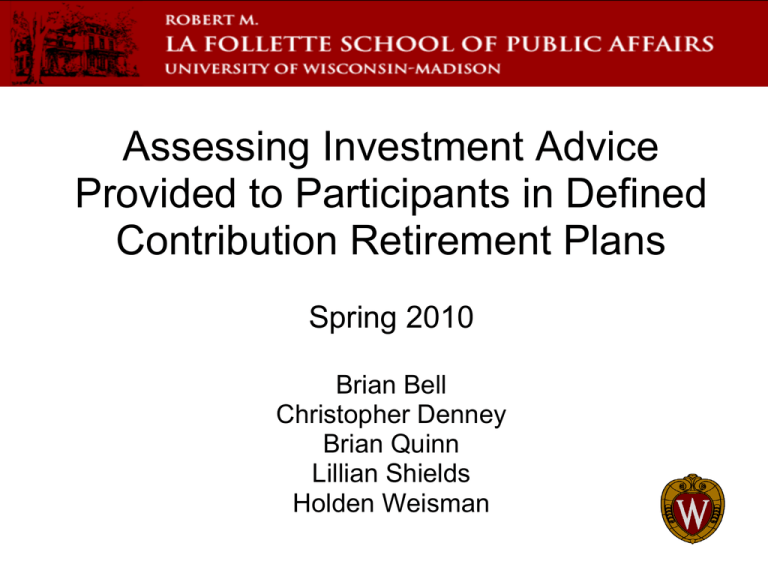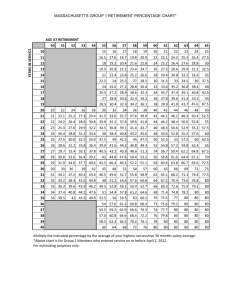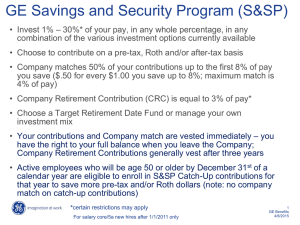retirement - La Follette School of Public Affairs
advertisement

Assessing Investment Advice Provided to Participants in Defined Contribution Retirement Plans Spring 2010 Brian Bell Christopher Denney Brian Quinn Lillian Shields Holden Weisman Overview In this presentation, we will... • Explain our research question • Provide background information • Discuss our four key findings • Highlight recommendations for further research Research Question • Study commissioned by the Government Accountability Office • What is the status of investment advice available to participants in defined contribution retirement plans? o Sources of advice? o Level of participant comprehension? o Level of utilization of advice? o Extent to which advice affects investment outcomes? Background • Recent shift from defined benefit plans to defined contribution plans • Structure of a defined contribution plan Deficiencies in Retirement Savings • Assumptions for determining “adequate” retirement savings • Average account balances lower than recommended • Why are balances low? o Low contribution rates and plan design o Mistrust of financial institutions o Failure to rebalance o Responses to market shocks Legal Structure • Employee Retirement Income Security Act of 1974 (ERISA) o Fiduciary duties o Prohibited transactions • SunAmerica Opinion - 2001 • The Pension Protection Act of 2006 (PPA) o Fee-leveling o Computer model o Regulations pending Findings • Goals of the report o Identify issues and concerns o Present opportunities for future research • Methodology o Interviews o Literature review Finding 1: Participants Receive Advice From a Variety of Sources • Lack of research on sources of investment advice • Participants receive advice from a variety of sources o Human Resources o Peers - informal advice o Online sources o Financial advisors Finding 2: Women and Participants With Higher Incomes Are More Likely to Seek Advice • Lack of research on participant willingness to seek advice • Demographic groups who are more likely to seek advice: o Women o Participants with higher incomes o Increases with age o Participants with more education Finding 3: Most Participants Have a Poor Understanding of Fees • Most participants do not fully understand: o What fees are charged – - Fees are not itemized – - Fees are expressed as an expense ratio o The significant effect fees have on returns Finding 3 (continued): Most Participants Have a Poor Understanding of Fees • Many employers also do not fully understand vendor fees • Most plan sponsors do not use a level of services commensurate with the fees charged • Some evidence suggests that plan sponsors are attempting to reduce their fees Finding 4: Effect of Investment Advice on Plan Outcomes Is Ambiguous • Hewitt Associates study: advice has a large, positive effect on outcomes • RAND: automatically provided advice has negligible impact • Long term effects of target date and target risk funds have yet to be determined • Some evidence suggests that plan sponsors are improving plan design to increase plan assets Conclusions: The Big Picture • Lack of data and standardized research methodology • Lack of access to adequate advice • No standardized process for receiving advice • Many participants lack basic financial literacy skills including understanding the impact of fees • Automatically provided advice is not effective • The importance of plan design Recommendations for Further Study • Standardized methodological approach • Advice sources and effectiveness • Final Pension Protection Act regulations • Financial literacy • Post-retirement advice o Portability of DC plans o Effectiveness of changes at different levels o Plan sponsor vs. participant Many Thanks to... • Government Accountability Office o Sharon Hermes o Anjali Tekchandani o Amber Yancey-Carroll • UW-Madison La Follette School of Public Affairs o Andrew Reschovsky o Karen Holden o Karen Faster • UW-Madison Department of Consumer Sciences o Rob McCalla o Michael Collins • Hewitt Associates o Yan Xu Questions?











